Archie’s Malamar
I love Malamar. Every now and then, I tinker with it in expanded despite Parallel City, N, and Garbotoxin Garbodor. Most players probably consider Malamar unviable in expanded, but I think that very attitude lets it steal wins from opponents. But before I dive into my most recent Malamar list, I want to briefly discuss two lists I used or recommended in the past few months but did not cover in any past articles. First, I show off the list one of my locals, Jeff Kang, took to Top 64 at his first Regionals in Roanoke. Second, I cover some of my personal experiences piloting Malamar in Expanded in the Celestial Storm format. Finally, close the article with with a deep dive into my latest and most successful build: Archie’s Malamar.
Malamar / Zoroark-GX – Jeff Kang’s Roanoke Build
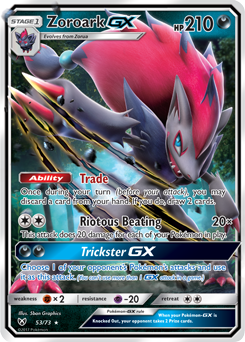
I drove to Roanoke with one of my locals, Jeff Kang. He felt the most comfortable piloting Malamar, winning his first cup with it, and wanted to play it at Roanoke despite the threat of Brokan Deck. So I tried to build him a powerful, consistent list with a decent shot at beating Decidueye-GX variants. A thin line of Zoroark-GX became the go to choice. Zoroark-GX boasts a lot of hit points to soak up Feather Arrows and an attack that sets up Black Ray numbers. But most importantly, it draws cards. Decidueye can steal games by gusting up a Malamar and attacking it with Fairy Alolan Ninetales-GX. Zoroark helps insure you draw out of bad scenarios such as those. Generally, I want my tech cards to swing matchups heavily. Zoroark-GX may not swing the Decidueye matchup into a favorable one, but the Trade Ability strengthens the deck’s overall matchups spread enough to justify the slot.
Jeff would later Top 64 the event, losing to three stall decks in day two. Unfortunately, I did not expect the staggering number of degenerate decks that cropped up at Roanoke. If I did, a single copy of Switch or Escape Rope would auto win all of Malamar’s stall matchups. Jeff would later comment that he did not need the single copy of Zorua, and would cut it for additional consistency slots.
Given Jeff’s success, particularly at his first ever Regionals, I would highly recommend a single copy of Zoroark-GX in Malamar lists going forward. I would later copy the same concept into Expanded.
Ability Lock Malamar – Celestial Storm Build
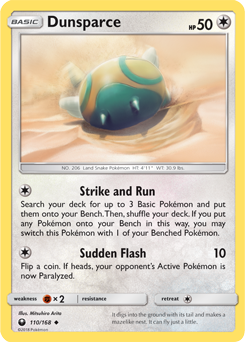
Following the release of Celestial Storm, I made a Malamar list that took advantage of the Dunsparce reprint. Note that the list does not include cards from Lost Thunder as I played this list before Lost Thunder came out.
Similar to Chimecho in our standard format, this version of Malamar aimed to buy time by using Wobbuffet to lock your opponent out of their Abilities while you try to set up. The deck tries to retreat into the Wobbuffet on its first turn in most matchups. You can manually retreat to do so or copy Strike and Run from Dunsparce using Marshadow-GX to simultaneously set up your board and bounce into Wobbuffet. Later in the game, you can copy Dark Corridor from Gengar-EX to continue leveraging Ability lock. I would primarily use something like Dark Corridor with Marshadow-GX to hit into Seismitoad-EX or Zorua from Zoroark variants, but it does serve some niche uses outside of that matchup.
The deck did quite well for me at local cups and private testing, taking down a few Drampa-GX / Garbodor, Zoroark-GX / Garbodor. I enjoyed it a lot, but I would not expect it to steal wins against more experienced Zoroark and Garbodor players. Regardless, I do not want to talk too long about a deck from last season’s format, when I could focus about the latest spice: Archie’s Malamar.
Archie’s Malamar – Latest Expanded Build
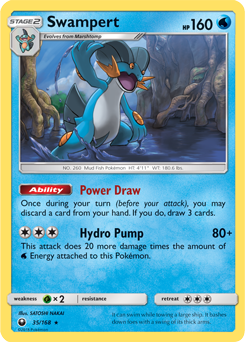
The Archie’s variant does not actually incorporate any new cards from Lost Thunder aside from the Giratina. Rather, the idea came up after Jeff Kang’s performance at Roanoke. The deck sets up more explosively than older Malamar variants and the extra card draw opens up plays I would consider too card hungry for a Malamar archetype. Unfortunately, I cut the Wobbuffet as it would shut off my own Swampert. Losing Ability lock hurts a lot of matchups, but the added draw power more than makes up for that loss.
I like the above list a lot. The addition of Exeggcute alone improves the consistency of Malamar even in games where you fail to set up Swampert. But when the list does hit the turn one or turn two Swampert, you checkmate any deck short of Garbotoxin variants. It took significant experimentation to reach the aforementioned list, so let me discuss my experimentation and rationale next.
Trial and Error – Past Iterations
Archie’s Swampert Lines
When I started testing, I ran a 2-2 line of Archie's Ace in the Hole and Swampert. That tested horribly. No matter how many Trainers' Mail or Order Pad you fit in the list, Malamar will never hit turn one Archie’s reliably enough to center your deck around it. I spoke to Sam Chen, and as he put it, hitting Archie’s consistently means minimizing the number of “Terminal Cards” in your deck, I.E. cards you cannot play down turn one. But Malamar still needs to run four copies of Malamar. So rather than make Archie’s Swampert a necessary focus of the deck, I built it as a strong pick up whenever the combo does happen. I cut the Archie and and Swampert count down to one each to reflect that. I replaced the two deck slots with additional copies of hard draw Supporters, as Malamar can still function reasonably well with just raw draw support. After testing both 1-1 and 2-2 lines, I like 1-1 better, but may test a 1-2 Swampert-Archie’s line in the future to improve prizing-related-issues.
Exeggcute
I added Exeggcute to the list when I started testing the Archie’s engine. The eggs put in tremendous work, even in games where I whiff or Prize the Archie’s setup. Honestly, looking back, I question why I never ran these in my past lists. I kind of feel like a bit of an idiot in hindsight. Right now I run two copies, but I could see myself cutting down to one if I feel desperate to include a tech card.
Order Pad
I tried replacing Trainers’ Mail with Order Pad. It did not run nearly as well. Order pad did not improve my Archie’s setup significantly, and Trainers’ Mail functioned better in the late game, helping maintain a larger hand size than Order Pad and searching out the ever important Parallel City. I do not believe the deck offers enough space to run both Order Pad and Trainers’ Mail.
Red Card and Delinquent
When I first built the list, I figured I might as well try using the same Red Card plus Delinquent combo that Zoroark players abuse in expanded. Specifically, two copies of Red Card and one copy of Delinquent. After all, my deck trades now too! I also considered Morty as an option as it functions similarly to Delinquent. Morty works much better against non-Zoroark decks, as you can more reliably strip them of their draw support. However, it performs much worse against Zoroark decks as you would rather force discards.
I cut Morty early on as it felt much more reactive, and I expect potentially as many as half of my opponents at a Regionals level event to run Zoroark. I would later cut Red Card and Delinquent altogether. I do not feel like Malamar leverages Red Card Delinquent quite as well as Zoroark. The Hit Points of Zoroark-GX itself plus the existence of both Acerola and Trashalanche in many Zoroark lists really push the value of Red Card Delinquent over the top. Additionally, Malamar feels like it needs more cards to set up its game plan than Zoroark, which can start attacking for just a Double Colorless Energy and a single Stage 1.
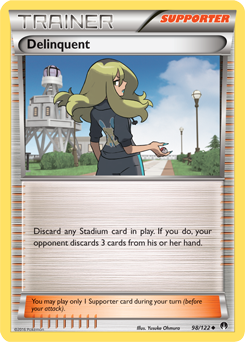
Furthermore, you need to set up your Swampert to effectively leverage Red Card combos in the first place. But this deck cannot hit Archie’s reliably enough to do that. When you whiff Swampert, each copy of Red Card, Delinquent, and Morty feels like a dead card.
But before I move on, I want to note the inclusion of Devouring Light Giratina could change my mind on the matter. I did not test this combination yet, as I did not want to sacrifice more consistency. But Giratina does help with both the Greninja and Trevenant matchups while simultaneously providing additional synergy with the Red Card Delinquent combo, forcing your opponent to discard their entire hand, rather than let them keep a potential draw Supporter.
Parallel City
In order to both protect my own deck from Parallel City and to make the Zoroark matchup more manageable, I chose to run three copies of Parallel City. I ran two in earlier lists, but always found myself wanting more. With three Parallel City and four Trainers’ Mail, you should, on average, win the Parallel City war against a Zoroark deck running only two copies. Zoroark decks typically burn their first Supporter on Brigette, whereas Malamar decks can just immediately rush through their deck with a turn one Archie’s or Sycamore. This means, you will hit turn one Parallel City more often than a Zoroark player. Utilizing Marshadow-GX, you aim to combine Parallel City with quick Knock Outs that cripple your Zoroark opponent’s board state. No cheeky Chimecho or Wobbuffet plays here, this deck simply aims to out-aggression, out-parallel, and out-draw your Zoroark opponent.
Basic Matchup Advice
Many of you probably do not have experience piloting Malamar in Expanded, so let me offer a few quick tips.
Buzzwole-GX
Buzzwole-GX can compete with Malamar decks if they manage to disrupt your setup. So you should focus on swapping a Lunala Prism Star into your Active early and using its attack to attach Energy. Buzzwole beats Malamar by limiting the Malamar and then attempting to sweep with Lycanroc-GX. You beat that by constantly presenting energized threats and Lunala Prism Star can energize itself as a threat on your first turn going second. Likewise, you should avoid playing Pokemon-GX, even if Moons Eclipse GX seems tempting. If you can attack with Giratina for a Knock Out, you generally prefer to do that instead. The matchup would feel much closer if you cut Lunala Prism Star from the list.
Drampa-GX / Garbodor
Drampa-GX / Garbodor matches tend to transition from an Item conservation phase to an all out deck thinning phase. Early on, you want to leverage Lunala Prism Star to load a large number of Energy onto the field while playing minimal Items. Drampa-GX / Garbodor tends to lack tools to efficiently combat a Lunala Prism Star, at least efficiently, frequently allowing you to take a Prize lead. A smart Drampa-GX / Garbodor player will leverage their Tapu Lele-GX as the primary attacker against you, so place Giratina Ability damage on their benched Tapu Lele-GX when you get the chance, as the 10 extra damage means one less Energy with Lunala Prism Star to threaten a KO.
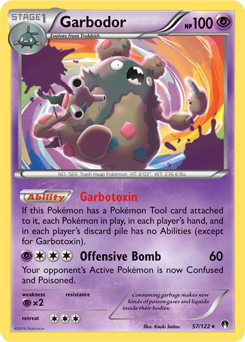
With some luck and solid play, Lunala should leverage both a Prize lead and enough time to manually attach some additional Energy onto your follow up attacker. At this point, begin milling your deck of dead cards. With four Battle Compressor, four Mysterious Treasure, and four Ultra Ball, you should get to a point where you can expect to almost always draw either a VS Seeker, Field Blower or Trainers' Mail off an N to two or three cards, establishing a near checkmate scenario.
And of course, do not forget to spam Parallel City in this matchup. Limiting their Garbodor line greatly reduces the number and diversity of threats you need to contend with.
Greninja BREAK
You will utilize Giratina and Lunala Prism star as attackers in this matchup. Do not sweat the Prize race in this matchup. You typically lose the moment both your Giratina and Lunala Prism Star die regardless, as you do not have a way to recover your Energy through Ability lock. Lead with Giratina, knocking Frogadier and Greninja, before ideally transitioning into a Lunala Prism Star to hit a bigger number against the eventual Greninja Break. You want to take your first few KOs with Giratina’s Shadow Impact, placing damage on Exeggcute to give your opponent Prizes. Doing this prevents them from playing Counter Catcher or Ace Trainer. It also cripples their N and makes N a viable disruption card on your end. Leveraging your Giratina damage correctly seems counter intuitive at first, but it makes a huge difference in the matchup. Remember, do not think of the matchup as a Prize race. You lose the game the moment you lose two key Prizes: your Lunala Prism Star and your Giratina, so you should consider the remaining four Prizes expendable.
Latias-EX
One card exists for stall decks to stop Malamar in its tracks: Latias-EX. The deck only runs one answer to it: Lunala Prism Star. But if you ever discard that, you lose it forever. So you need to stay mindful of decks that could run Latias-EX against you, and to conserve your Lunala Prism Star should you ever encounter them. In particular, keep an eye out for Sableye and Primal Groudon-EX.
Trevenant BREAK
You beat Trevenant by applying a lot of early pressure before they get the opportunity to evolve into too many Trevenant BREAK. It also helps tremendously to limit your Bench. You only need one Inkay and one Malamar to energize a Dawn Wings Necrozma-GX if you simply attach an Energy on your first and second turns. I would definitely avoid playing more than two Inkay on my first turn at any rate. I personally opted to cut Devouring Light Giratina from my list. In my experience, Trevenant needs to draw a lot of cards to simply compete with the constant pressure of Dawn Wings Necrozma-GX hitting with Dark Flash every turn. You can also put a Giratina in the Active an attach a single Energy, to threaten a Knock Out the next turn if your opponent places a Dimension Valley onto the field. Also beware of the possibility of Alolan Muk techs in Trevenant lists now that Ditto Prism Star exists. And once again, the strategy of killing your own Exeggcute can sometimes work against Trevenant too.
Shaymin-EX
I use Shaymin-EX to encompass a number of archetypes that utilize it. Night March, Mega Gardevoir, Turbo Darkrai, Mega Rayquaza, Sky Field Zoroark, to name a few. The inclusion of Giratina makes most Shaymin-EX matchups an autowin for Malamar, with perhaps the exception of decks like Mega Gardevoir that can discard their Bench. You can place damage counters on their benched Shaymin-EX and then follow up with a Black Ray-GX to take a lot of Prizes at once, or even just two Prizes while simultaneously putting other Pokemon in range of Giratina.
Zoroark Variants
A lot of different Zoroark builds exist in Expanded. Ranging from the Zoroark-GX / Seismitoad-EX / Control, to Zoroark-GX / Garbodor / Klefki, to Zoroark / Delinquent / Control, or even old throwbacks like Zoroark-GX / Lycanroc-GX. Teching for all of them feels very difficult, which is why I like the idea of three Parallel City. You can slow down any Zoroark deck by hitting them with an early Parallel City and then one or two more Parallel City as the game goes on. Malamar just needs to buy some time to set up and start the Prize race and simultaneously slow down Zoroark’s draw engine.
The Zoroark-GX / Garbotoxin variant gives Malamar the most trouble. With only two copies of Field Blower in the current list, I usually cannot break Ability lock enough times over the course of a game to recover enough Energy. A few cards could solve this issue. Faba could give the deck seven total outs to breaking Ability lock, but would slow the deck down dramatically. Zoroark-GX possesses enough hit points to attack twice under Ability lock against a Zoroark-GX / Garbodor deck, while simultaneously offering a backup draw support Pokemon when you miss turn one Archie’s. Or simply a third Field Blower could give your deck a bit more reach.
I worry about the Zoroark-GX / Seismitoad-EX / Control the second most, as they can lock in their own Parallel City with a Quaking Punch. Specifically, I mean the variant that won Portland Regionals. But I believe the inclusion of Faba in the format should dissuade most players from this version.
Against the remaining Zoroark archetypes, you can just attempt to Prize race them by hitting them with Parallel City over and over while taking Knock Outs. If you set up and execute that strategy, you eventually run the Zoroark player out of at least one key resource, be it total attackers in deck, number of trades available on their next turn, etc.
For Anaheim, the threat of Garbotoxin in Zoroark variants probably seems too significant to consider Malamar. However, I actually consider Garbotoxin a bottom table threat in the North American metagame. If a Malamar player actually makes it through the first few rounds, it could perform quite well in day two. When you look at Portland Regionals, 20 Zoroark decks made day two, and only three of them played Garbotoxin. All the big name North American players I keep an eye on chose to either play Trashalanche Garbodor without Garbotoxin, or to the entire Garbodor line.
When most players look at Garbotoxin, they see one of the strongest Abilities in the game, and automatically include it in their deck. These players tend to overlook the number of deck slots needed to run Garbotoxin. Garbotoxin demands the Garbodor line itself and copies of Float Stone and Klefki to activate the Ability. In terms of deck space, it effectively uses as many deck slots as a Stage 2. Many of the top tournament grinders realize this, and know they can get even better value for those deck slots than something as powerful as Ability lock. Rather than run Garbotoxin, they use their extra slots to improve their matchups in other ways. These deck slots matter the most in the Zoroark mirror, where games tend to devolve into resource wars. I expect the top North American players to run a list vaguely similar to the Zoroark-GX / Delinquent / Control variant piloted by Isaiah Williams at Portland that “tech” to the beat Zoroark-GX / Garbotoxin players at the event by simply not running Garbotoxin in their Zoroark variant.
So to conclude, I think Archie’s Malamar could actually take down an entire Expanded Regionals. But the sheer popularity of Zoroark-GX / Garbotoxin still makes it a risky prospect for day one of an event.
Untested Ideas
Shrine Spread
I disliked Shrine Spread decks in the past because they lacked the draw power to execute their game plan. They tend to shy away from Pokemon-EX/GX draw support Pokemon and do not take Prizes on a regular basis. But Swampert solves both of those issues. A Shrine spread deck, combined with Espeon-EX, might actually put up a better fight against Zoroark variants than the more aggressive, Knock Out focused version I presented earlier in the article. But I would need to test that more, and even if it did, I worry that it would not perform as well as an aggressive Malamar variant against the likes of Buzzwole-GX, Trevenant, Garbodor, and stall decks. Regardless, I may consider testing it down the line.
Double Colorless Techs
Double Colorless Energy opens up a number of powerful turn one disruption options for Marshadow-GX. Notably, you could Quaking Punch a Zorua for a Knock Out. It also lets you use Gengar-EX‘s Dark Corridor for just two manual attachments. But given the introduction of Faba to the Expanded format, I worry the inclusion of Special Energy would make your deck far too vulnerable to various Zoroark hate cards floating around the format.
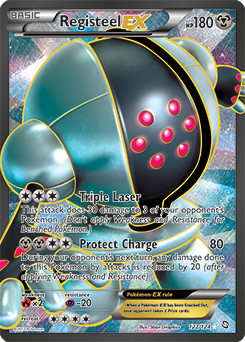
Triple Laser
Registeel-EX provides an interesting attack: Triple Laser. Combined with Marshadow-GX and Wide Lens, one could theoretically kill three Zorua in a single attack. Combine that with Chimecho to stop the Zorua from evolving and you have a potential way to cheese Zoroark opponents out of games. You would want to run a single copy of Korrina as well to make the combo more searchable. I do not expect this combo to work well practice. It takes a lot of cards, which makes it both difficult to pull off and makes your deck less powerful and consistent in other matchups. But worst of all, your opponent could just lock you out of the combo by declaring Quaking Punch.
I probably would not play the Registeel-EX plus Wide Lens wombo combo, but I do not hate Registeel-EX as a one of tech. It helps shore up matchups against Night March, Lost March, and punishes Sky Field Zoroark variants if they ever try to play Exeggcute to reach for some extra damage.
Chandelure-EX and Hoopa-EX
Chandelure-EX can put four damage counters for a single Psychic Energy. Perhaps combined with a thicker Marshadow-GX line, you could use this to surprise snipe a Ditto Prism Star from a Zoroark opponent. Hoopa-EX can snipe for 100 damage, but requires much more Energy to do so. Sniping a benched Basic on the same turn you parallel can cripple a Zoroark opponent, similar to how pre-rotation Zoroark-GX / Lycanroc-GX decks aimed to cripple their opponent’s setup with the combination of Parallel City and Bloodthirsty eyes. Currently I do not run either, as I still want to focus on the consistency of my list, but I could see Hoopa-EX making the cut. Chandelure feels too niche to see play, and the dark Weakness makes it a bigger liability in comparison, but I still wanted to mention it.
Rayquaza-GX
The Archie’s Swampert engine could potentially fit into a number of archetypes. Of the ones that use Mysterious Treasure, Rayquaza-GX also comes to mind. Without the Stage 1 Malamar line, it could hit the turn one Swampert more consistently than Malamar. And the combination of Battle Compressor with Latias Prism Star and Zeraora-GX could make the Zoroark-GX / Garbotoxin matchup much more manageable than the Malamar counterpart. However, Rayquaza-GX threatens a much weaker Prize race than Malamar, which offers the options to both spam Giratina and buy a turn with Moons Eclipse-GX. To compensate for that, I introduce the Red Card Delinquent engine, in the hopes of buying enough time to take six Prizes with Dragon Break:
I lay the below list as a starting point. And I want to put heavy emphasis on starting point, because I doubt it could beat any matchup reasonably often as shown below. But, every list starts somewhere, and I would probably start there to get a feel for what issues I need to resolve the most.
Conclusions
I really enjoyed toying with Malamar in Expanded these past weeks. It turned out much more viable than I expected. I have yet more ideas to explore and test, and could see myself piloting it to Dallas after a bit more fine tuning. Unfortunately, its awkward Zoroark / Garbodor matchup likely locks it out of Tier 1 status. But I like my current list a lot, more than enough to pilot it at an Expanded League Cup with confidence. If want to ask any questions, please feel free to message me on the Subscriber’s Hideout as always. Good luck to you all, and see you guys again in my next article, presumably on the Team Up! format.

